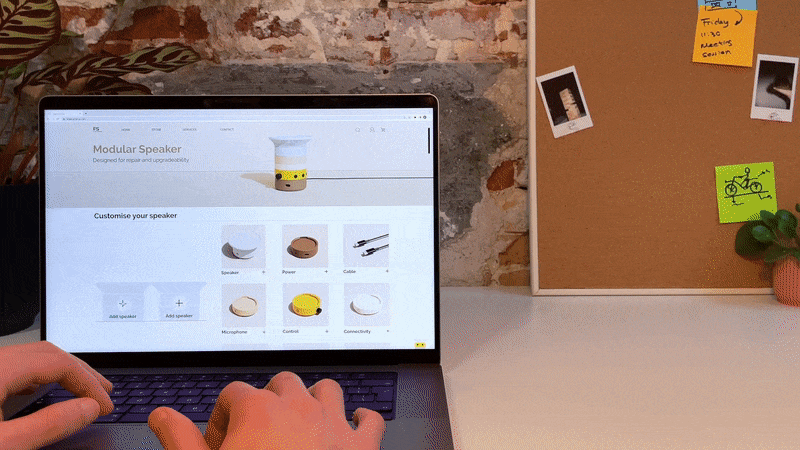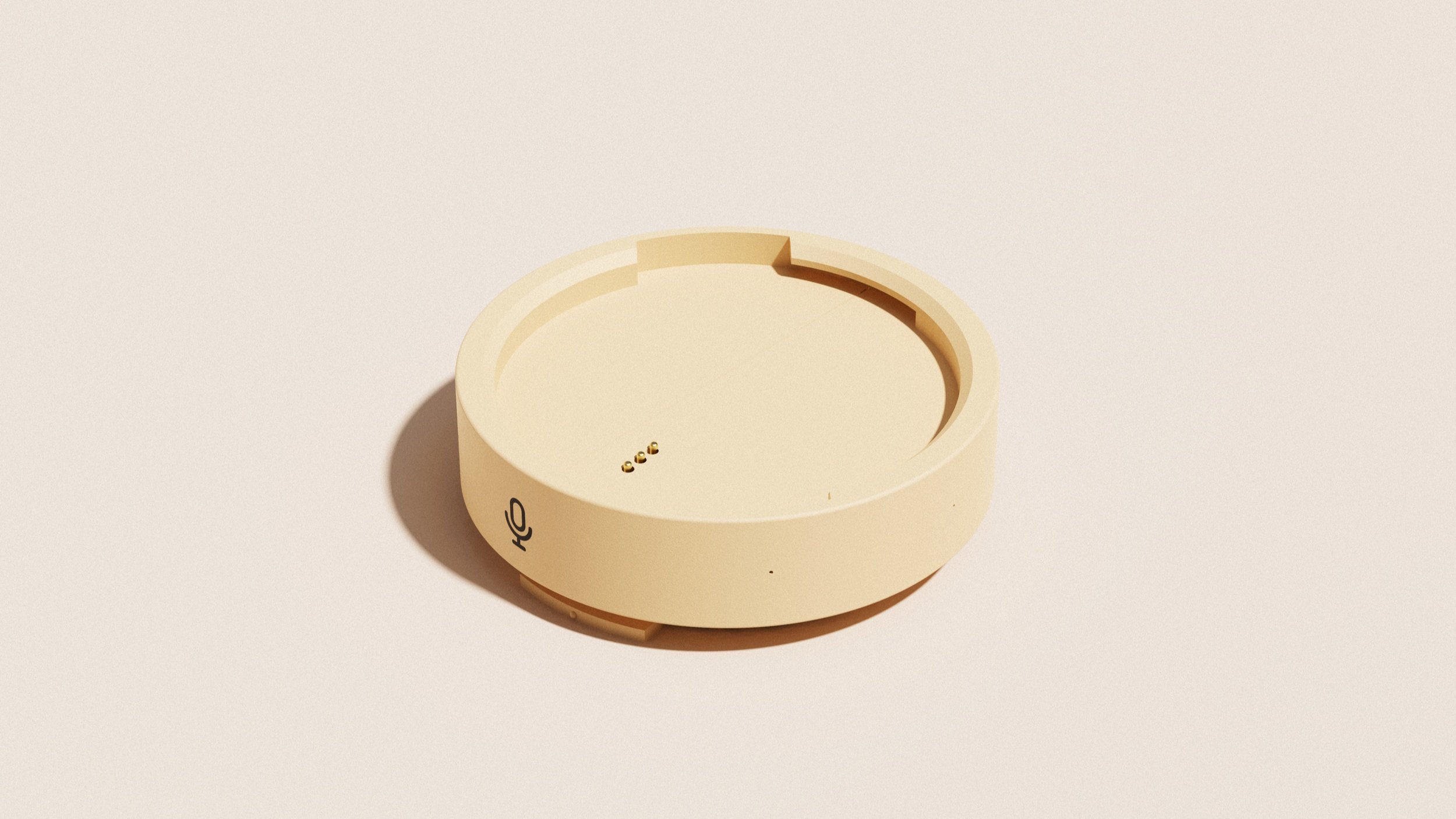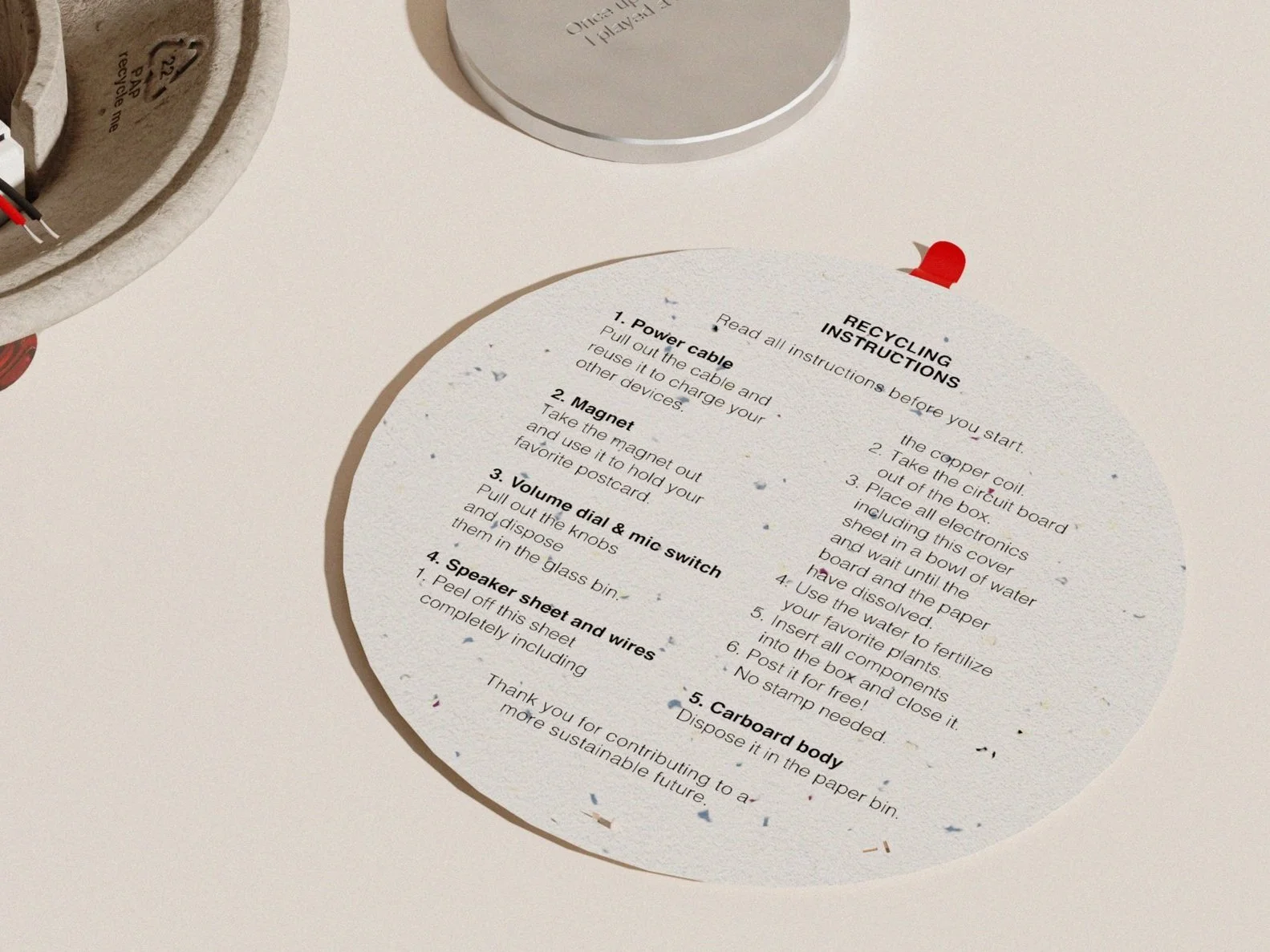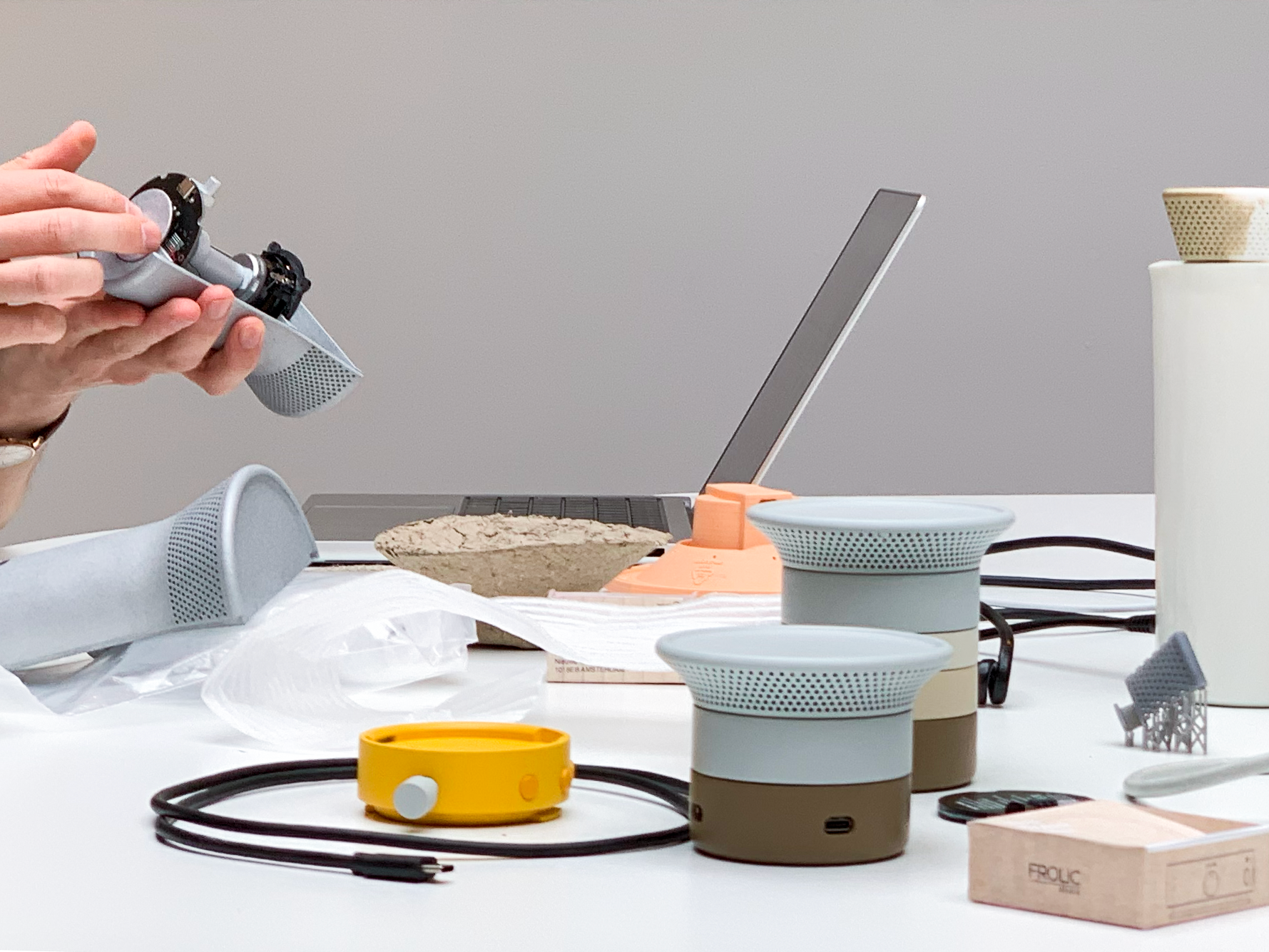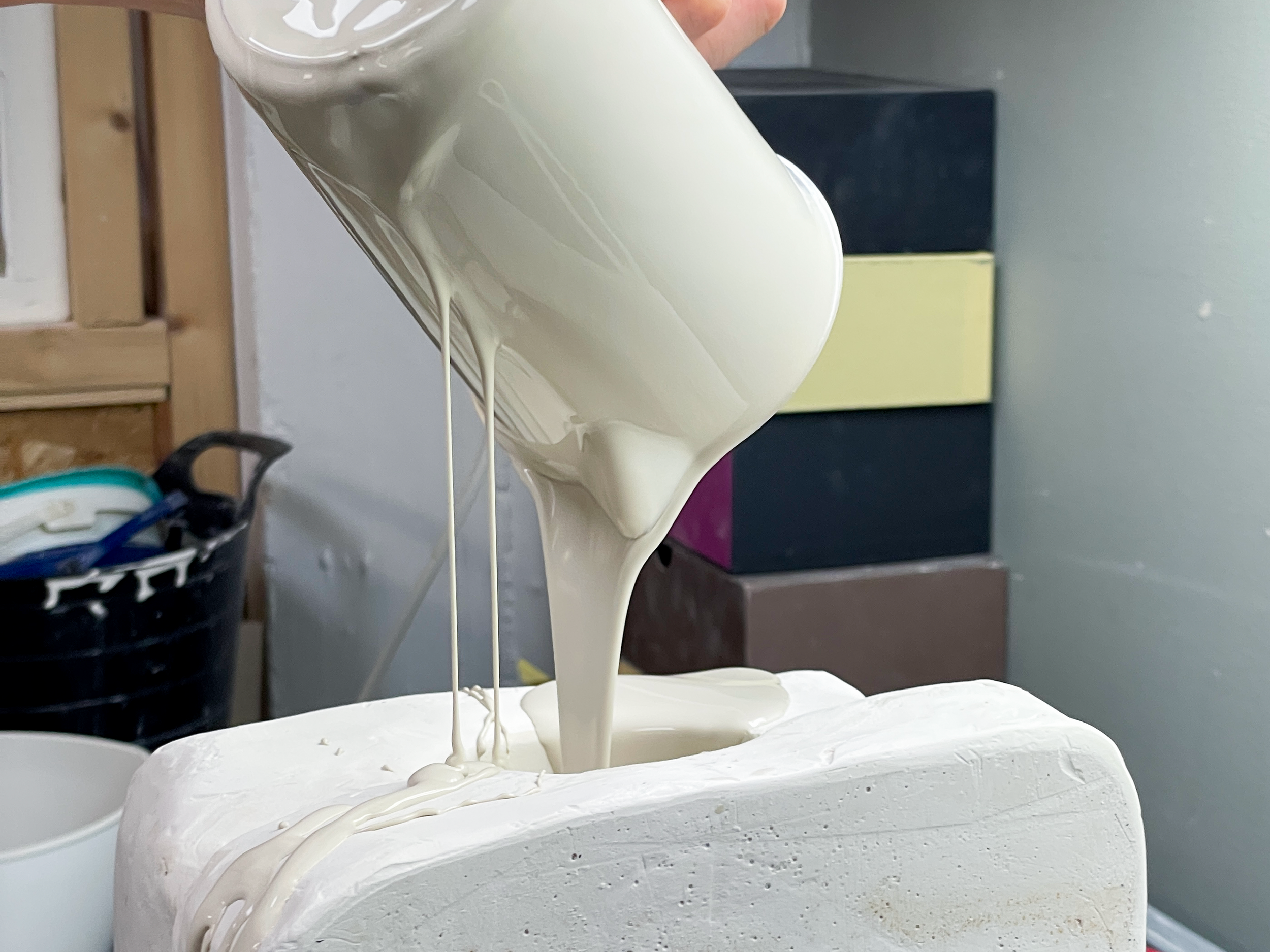One smart speaker, four circular tunes
There is no one-fits-all solution to decrease the impact products have on our planet, but some design strategies can bring around better outcomes.
A resonating challenge
Most products are designed for a linear lifecycle, starting with non-renewable resources and ending as waste in landfills. And many of us continue to engage in unsustainable behaviours, such as buying new products when old ones break or do not have the latest features. This linear model is not sustainable, and as resources become scarce and waste accumulates, we must shift to a more circular one.
One smart speaker,
four sustainable concepts
Worldwide, smart speaker sales are predicted to reach over 400 million by 2025. With so many devices being produced, can we design them to have a lighter impact on the planet? How would they look and function? Using sustainable design principles, we created four unique concepts for the same smart speaker. In developing each concept, we challenged ourselves to unfold and break down the incredible diversity of aesthetics and functionalities that can originate from and within the same product as soon as different circular strategies are put under the spotlight.
1.
Designed for
repair & upgradability
2.
Designed for
reducing & recycling
3.
Designed for
remanufacturing
4.
Designed for
longevity
Intervention of circular strategies in the traditional linear product lifecycle
Speaker #1
Designed for repair & upgradability
A customisable smart-home speaker that evolves and adapts to your changing needs
Say goodbye to the old days of constantly replacing the whole device when just one part breaks or needs updating. The speaker is designed to prevent the creation of new waste and decrease both your and its environmental impact.
Designed for repair & upgradability: In a nutshell
Modularity at the core: providing flexibility to facilitate the repair and upgrade
Mixing and matching different modules to your liking is possible through an intuitive twist-lock mechanism. Pogo pins connect the modules, powering your customised speaker.
Modularity does not stop there: you can interlink individual speakers, wirelessly or via standard USB-C, to fashion a stereo or multi-speaker setup.
Future-proofing: the power of desirability
The speaker features a recycled plastic body and standardised, compatible parts. As additional modules are available for purchase, you can personalise your speaker and switch in or out single units for connectivity, control, sound output and more.
Since the speaker is easily modified and adapted to your changing needs or new features, it remains functional for years to come, prevents obsolescence and encourages sustainable behaviours.
The modules you purchase are delivered in a cardboard box designed to fit through the mailslot to increase shipping efficiency.
Accessible repair: love the speaker, but is it not working anymore? Accessible repair comes to the rescue
The QR code at the bottom of each module leads you to the self-assessment repair tool. The hardware schematic is open source, the chips and components are off-the-shelf, and each module is opened effortlessly. Thus, the repair can take place at a shop, or you can do it yourself at home.
Connecting the speaker to a laptop allows you to run a complete diagnosis: a tailored troubleshooting test identifies the issue and provides a list of nearby repair shops and DIY repair tutorials.
Speaker #2
Designed for reducing & recycling
The most sustainable product is one that is never created in the first place
When designing a new product, its whole lifecycle’s impact must be minimised. This speaker focuses on manufacturing for minimal raw material depletion and sustainable end-of-life options.
Designed for reducing & recycling: In a nutshell
Sticking to the essentials: reducing to keep production resources and impact low
Compression-moulded paper fibres - an abundant, inexpensive and recyclable material which requires little energy during production - primarily constitute the speaker.
The audio signal is fed through a copper coil suspended over a magnet to create a magnetic field, make the paper membrane vibrate, and pass sound waves through the air. The speaker features no permanent fixtures to reduce its environmental impact. This also allows the essential components, such as the copper coil, the paper membrane and the neodymium magnet, to be easily separated.
Guided disposal: straightforwardness and accessibility for a correct and thoughtful end-of-life
Pulling the red tag on the back of the speaker reveals not only the internal electrical elements but also instructions to guide you through the speaker’s disassembly and disposal processes.
The speaker’s Jiva printed circuit board (PCB) features a substrate made of natural fibres instead of the typical fibreglass and epoxy resin alternatives. This allows easy separation of the electronic elements and their routing from the substrate by simply submerging and stirring the PCB in warm water.
You can place the electronic elements in an included pre-paid envelope to return all electronics to the manufacturer free of charge. The woofer copper coil needs to be added to the envelope too.
Recycling & repurposing: when the end of life matters already in the design phase
The speaker features many recyclable materials to ensure they fit in the most common domestic waste streams. The speaker’s main body can go to the paper waste, the buttons made of glass to the glass waste, and the PCB fibres to the organic waste - perhaps returning as your favourite recycled newspaper or carafe (or as a new speaker).
Each electronic element of the speaker’s PCB is returned to be sent for reprocessing - instead of ending in a landfill - and the natural fibre substrate is fully biodegradable. Typically, PCB’s fibreglass and epoxy resin alternatives are instead incinerated to extract the precious metals within. The woofer copper coil is also returned with the electronic components as no domestic waste stream can collect it. This way, it can be sent for recycling and energy recovery when possible. The speaker’s charging cable and magnet are repurposable in your home.
Speaker #3
Designed for remanufacturing
A smart-home speaker that is easy for you to return and for the manufacturer to refashion
Durable and recyclable materials, like aluminium, characterise the design of the speaker to ensure a long lifespan and retain value. So, when it is no longer possible or desirable to repair or adapt the speaker, its materials can be remanufactured to stay in the speaker’s lifecycle and reduce the overall environmental impact.
Designed for remanufacturing: In a nutshell
Take-back service: incentivising returns to the manufacturer with an accessible take-back service
A percentage of the speaker's retail price consists of a take-back deposit you can claim upon returning the product - just like for your glass bottles. The speaker’s QR code connects you to the digital take-back platform, where you could eventually purchase a new or remanufactured speaker.
Upon request of return, an auto-locking return shipping box is delivered as a flat package that fits into your mailslot. Removing your address sticker reveals the manufacturer's address for a quick and effortless return.
Ease of disassembly: making it easy for the manufacturer to take responsibility for returns
The speaker is designed with a low parts count, easily separable elements and without glues or welds for simple disassembly. A metal pin secures both housing halves and all other parts of the speaker. With a strong magnet, the manufacturer can pull out the pin, thus effortlessly separating all individual parts in just one movement.
Durability: increasing the value of remanufacturing with durable and traceable components
The speaker’s aluminium housing keeps its value over time, allowing for restoration, surface treatments and infinite recycling.
A strong information model makes replacing malfunctioning components straightforward and accessible. A scannable code on each part discloses all its information and history. Access to the (re)manufacturing history maximises the speaker’s durability by ensuring simple and continuous tracking of its parts’ lifecycles and eliminating the need for the manufacturer to refurbish the whole product.
When a refurbished speaker is packaged up, a sticker tracking its remanufacturing cycle is applied to the box to communicate the refurbishment history of the speaker and highlight its remanufacturing character.
Speaker #4
Designed for longevity
A smart-home speaker designed for a maximised use period and longevity to pay off most of its impact within its lifespan
Few things resonate more with caring about the future than designing something to be passed on to the next generations. This speaker is one of those things.
Designed for longevity: In a nutshell
Long-lasting: timeless materials for a timeless design
This porcelain and brass speaker is designed to provide value for multiple generations. Ceramic is chosen for its heirloom value and timeless appearance. The brass top provides a luxurious feel and a beautiful matte aesthetic which ages gracefully due to its patina effect.
Premium electronics: highest quality to match the speaker’s long lifespan
Audio components that have proven to work reliably over the last decades and are endlessly serviceable are mostly used. Via universal RCA ports, an easy-to-replace connectivity module is connected. You can update it to future standards or remove it entirely for the device to function as a classic analogue speaker.
Rethinking value: embracing new beginnings
Choosing ceramic for the speaker’s housing material allows for its repair through methods like the traditional art of Kintsugi.
In this way, a broken speaker does not need to be thrown away, and its aesthetic and emotional value are increased.
Wrapping it up
As a B Corp-certified design studio, we prioritise circularity in every aspect of the products we design, from production to end-of-life. Our commitment to sustainable practices is deeply rooted in our design process and informed by extensive research in sustainable product design interventions and applications. This project showcases how we move from knowledge to action, exploring the circular potential of a smart-home speaker through the development of four circular concepts. By doing what we love the most, we hope to inspire others also to embrace circular design principles and join us in the mission to create a more sustainable future. We believe that by working together, we can make a significant impact and lead the way towards a more circular world.
Process
Special thanks to
Sara Lourenço (ceramics moulding and casting)










